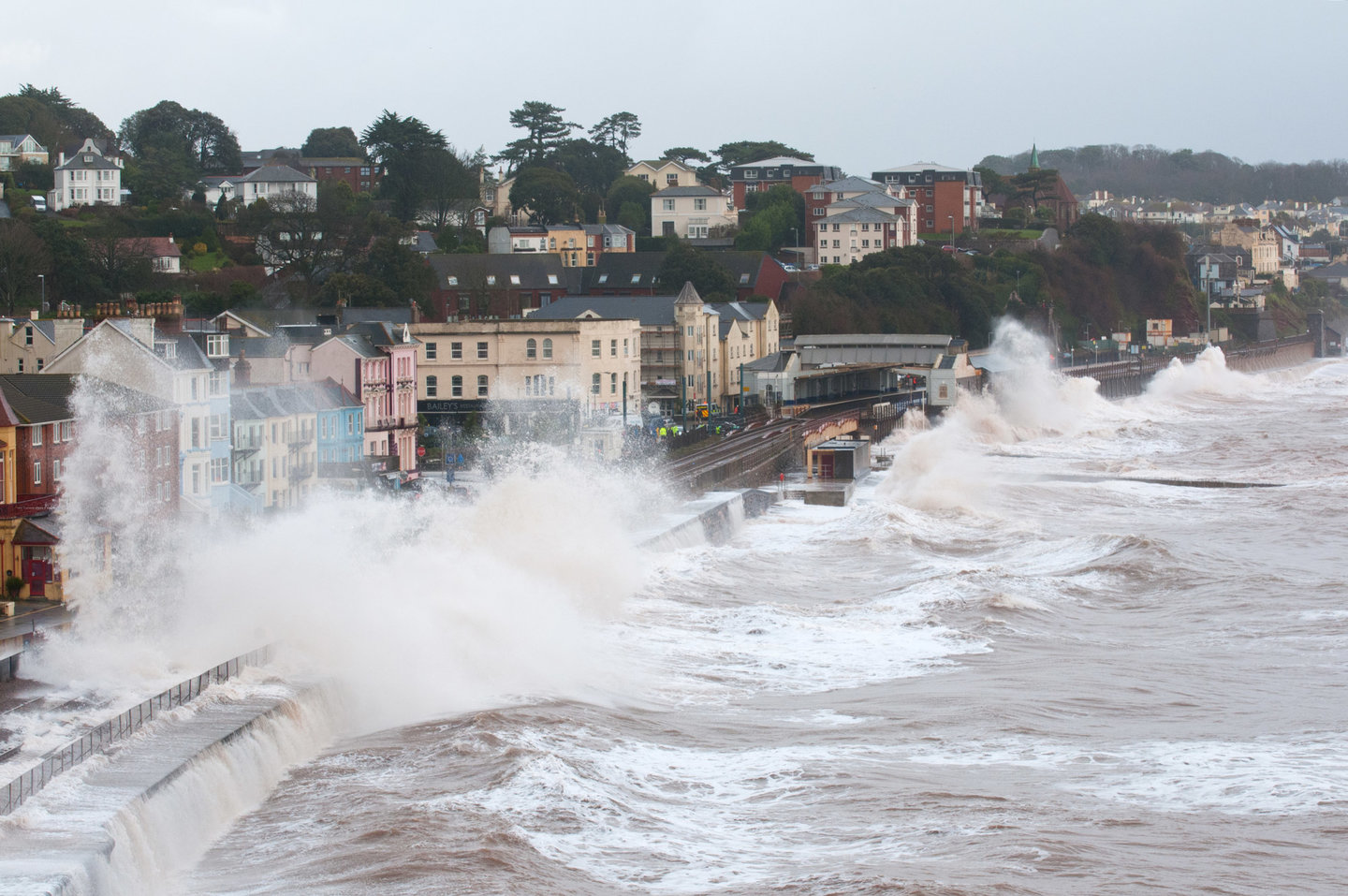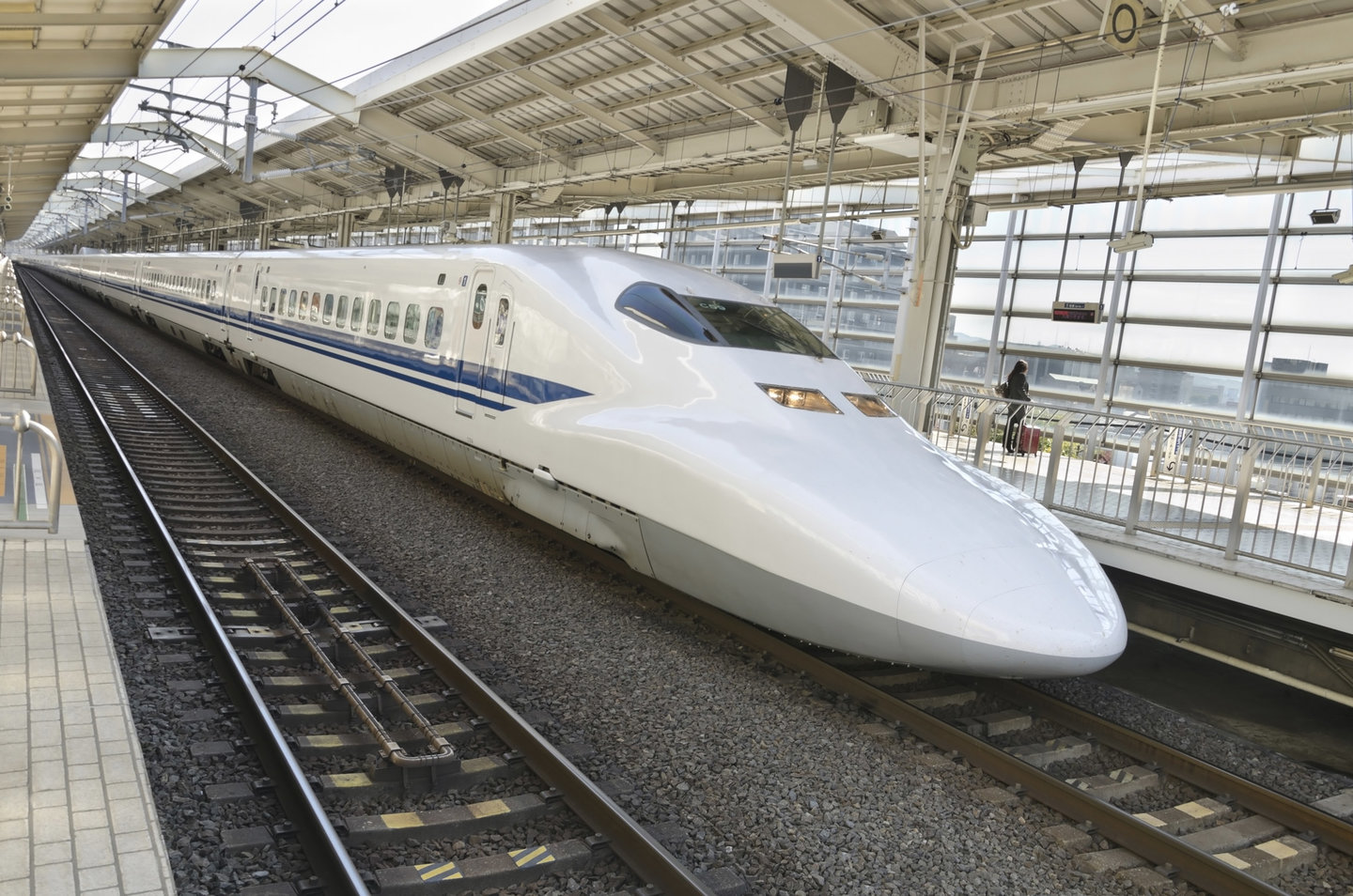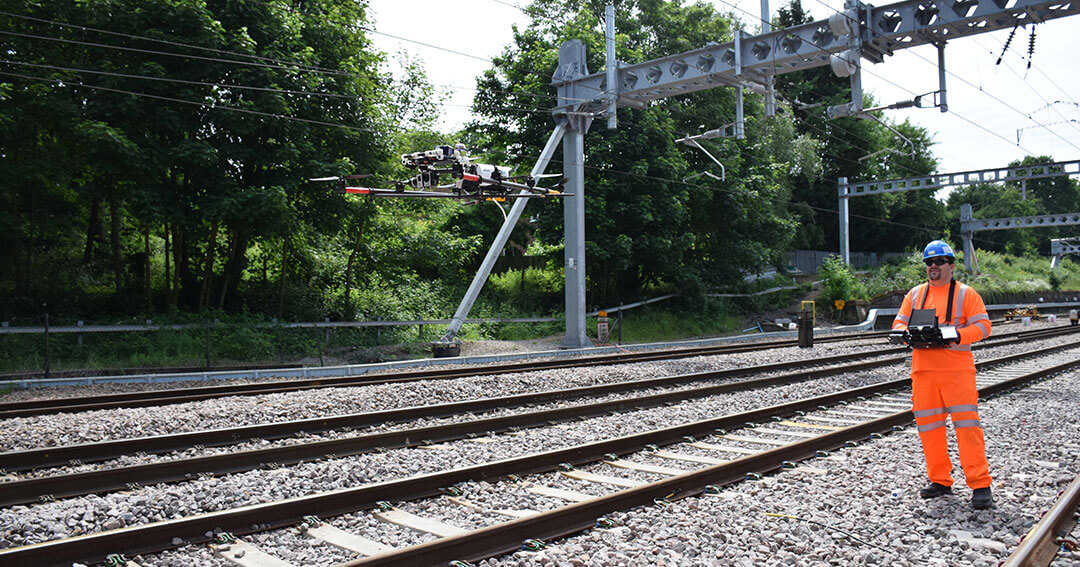Direct consequences of floods and high winds also include landslides, debris and leaves on tracks
How badly do storms affect the railways?
Storms and floods tend to have devastating effects on rail networks, businesses, houses, shops and more. According to estimates from the Association of British Insurers, damages from this winter’s two storms could cost as much as £360m, more than half of it set for the victims of floods.
Although no official figures were released on British railways, reports show many lines were severely impacted by high winds and floods during the winter storms, leading to closures and disrupted services.

Waves breaking over railway tracks in Devon, UK. Image: Carol Blaker | Shutterstock.com
Overall, there is little doubt over how badly rail lines can be impacted by extreme weather. According to UK rail infrastructure manager Network Rail, floods can wash away ballast, compromise signalling equipment and exhaust drainage systems.
Direct consequences of floods and high winds also include landslides, debris and leaves on tracks, and trees falling. All these problems do not just affect services but also delay intervention and maintenance. In addition, high winds are especially dangerous for engineers, who often have to wait until the storm has passed to intervene.
Are existing measures enough?
At this pace, the UK’s weather is expected to gradually worsen in all four seasons of the year - with summers becoming warmer, winters snowier, and mid-seasons rainier and more subject to storms like Ciara and Dennis.
This high degree of uncertainty and unpredictability is making it harder for companies like Network Rail and train operators to safeguard themselves and passengers when extreme weather strikes.

Storm Ciara hitting Porthcawl, South Wales, UK.
At the moment, Network Rail says it is relying on the most sophisticated weather forecasting technologies to ensure it catches bad weather before it’s too late. These include the company’s own Weather Service, a Flood Warning database, river-level monitoring equipment and the Washout and Earthflow Risk Mapping system, which “identifies earthworks that are likely to be flooded and assesses the risk of this happening”.
In recent times, the company and its equivalents across the globe have also started adopting thermal imaging and drones to monitor the state of tracks aerially.
With regards to containing damages, operators and managers are often updating and reinforcing equipment to protect it from future floods. In 2015, this was the case for signalling on the West Coast mainline in Cumbria, which was placed on 3m-high stilts for protection against the deluge. When Storm Ciara hit the UK earlier this year, it was reported that the line fared much better than it had four years earlier.
[Network Rail has] started adopting thermal imaging and drones to monitor the state of tracks aerially
The government has pledged to devote over £600bn for projects across the country
What are the main areas of intervention and who can fund it?
All the above are significant steps in the right direction, but if there is one thing we’ve learned from the past season of storms it's that plenty more needs to be done.
Having recently received new support from the UK Government, the industry will be spoilt for choice as it looks at areas of intervention. Indeed, before the Covid-19 emergency broke out in the UK, British Chancellor Rishi Sunak set aside £5bn for the regions that were heavily impacted by the storms. Adding to that, the government has pledged to devote over £600bn for infrastructure projects across the country.
A key starting point will be making existing infrastructure more resilient. As Railway Industry Association technical director David Clarke, recently told Global Railway Review, this should entail works on “earthworks, cuttings and embankments – which often date back to the construction of the railway – where water can cause washouts or trigger slips and failures that affect the safe running of the railway”.
In addition, efforts may have to be focused on preparing for longer and consecutive stints of bad weather, something that inevitably affected maintenance works earlier in February. Funds will also have to be distributed among both current and upcoming lines.
What can the UK learn from other countries?
With its long-standing record of heavy rainfalls and proverbial seasons of bad weather, the UK is no stranger to storms and floods and therefore has several examples to learn from.
Yet looking across the channel, several other countries have been adapting to a disruptive climate - implementing some measures that could be exemplary for struggling British operators.

A Shinkansen train in Japan. Image: Leon Rafael | Shutterstock.com
One example is the often typhoon-stranded Japan, a leading exporter of rail technology and a pioneer in high-speed rail. A land seasonally hit by earthquakes, bad storms and extreme weather, Japan has been upgrading its network to cope with climate change for a long time.
Having survived another such season in December last year, the country recently announced plans to lift parts of a holding yard for its famous Shinkansen trains by about 10m to tackle future floods.
Damage control measures can also be found in the US, where hurricanes, floods, storms and icy temperatures disrupt travel every year. According to the American Association of Railroads, Union Pacific crews raised eight bridges and 63 miles of track on a route alongside the Missouri River, as well as raising or removing track signals, to prepare for expected floods in early 2017.
Damage control measures can also be found in the US where hurricanes, floods, storms and icy temperatures disrupt travel every year
Engineers have already started looking into the use of machine learning, artificial intelligence and data science to carry out remote inspections
Could technology help in the future?
With more bad weather expected in the future, companies are looking at ways to use the latest technologies and measures to protect and maintain lines in times of crisis.
On the prevention front, upcoming rail lines like Crossrail, HS2 and Rail Baltica are working to make their new networks resilient before starting operations. Rail Baltica has even published a study that assessed the impact of climate change on its upcoming network. Here, the operator found that floods might increase in certain areas close to rivers and there will be high chances of multi-hazard risks in the coming decades.

A drone being deployed to inspect overhead equipment. Image: Network Rail
As for the maintenance of existing lines, there is much scope for innovation. First, future rail operations could heavily rely on the use of drones and remote monitoring equipment (like fibre-optic listening systems and CCTV) to identify lurking issues. Adding to these, a recent projectwithin the EU’s Shift2Rail initiative has found that optical and radar satellite data could be pivotal in future flood prevention activities.
In addition, operators and engineers have already started looking into the use of machine learning, artificial intelligence and data science to carry out remote inspections of tracks and develop increasingly efficient response strategies.
Ultimately, the success of these strategies will largely depend on forecasting and how far in advance operators will be able to prepare for incoming storms. Although said in the context of rising sea levels, these words by Network Rail senior programme manager David Lovell still ring true: “The only thing that we can do at the moment is, when there is a severe storm event, we will increase our inspections,” he told Future Rail last year. “We have a traffic light system that signals risks, so if we’re getting all this information and it’s high risk, we will stop trains running.”